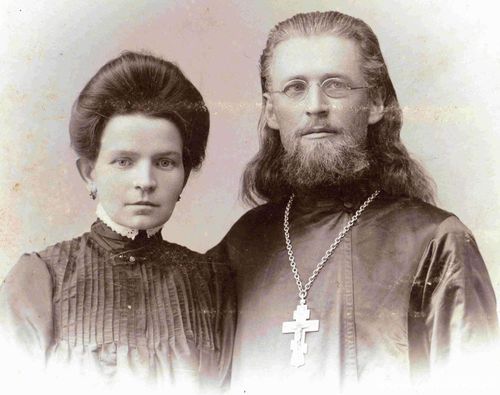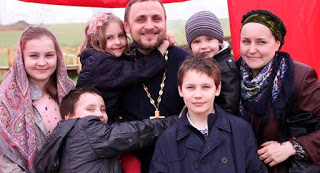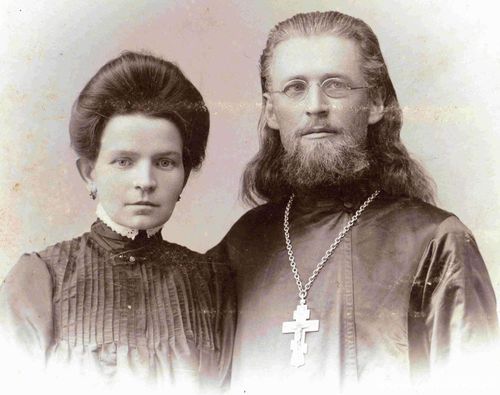
What does it mean to have a wonderful title, and no real job description? The position of the wife of a priest is exactly this. The various languages or every Orthodox country have titles of honor for the priest’s wife. Some might literally be translated as ‘priestess’, while some mean ‘wife of the priest’, and in at least one language — Russian — the priest’s wife is ‘mother’ or ‘little mother’.
So it’s clear that our Orthodox cultures have always seen the position of priest’s wife as something special. Yet there really is no “job description” for what she should do or be. This might be seen as a reason for confusion and frustration, but I think it’s more true to the nature of Orthodoxy to see it as the Church’s loving freedom, given to her children. It leaves a woman free to regard her position as a ministry which can be carried out in whatever way is most suitable and comfortable for her own character and personality. If there is no job description, there is no blueprint, either, to which any woman should feel obliged to conform.

The late Jacqueline Onassis was asked early in her husband John F. Kennedy’s presidency what she though her most important role would be as First Lady. She answered that it would be to take care of the President so that he could do his job effectively. And despite the differences in “style” of various priest’s wives, they, too, have this as their first task. Like any wife, the priest’s wife must help her husband carry out the demanding tasks that are his, not by taking part directly in those tasks, but by seeing to his physical, spiritual, and emotional well-being. If the family includes children, there are other things to be seen to. The priest’s family needs to be a healthy unit whose members’ needs are attended to. The members must also be allowed to grow through their mistakes and experimental “trying on” of various aspects of life. Most of all, there should be continual spiritual effort in the family, involving all its members.
We can say more about each of these points. First, seeing to a husband’s well-being: For a priest’s wife, this includes what it does for most wives — overseeing the diet, activities, and living conditions of her family. But it can also mean helping her husband feel confident in his ministry, encouraging him during rough times, and discerning what to tell him about the things she herself observes in the parish. Because so often there is little monetary or status-related reward for the priest’s work — as there is more likely to be in other professions — her support is particularly important.
The second point, the need for the priest’s family to be a place in which members’ needs are attended to, applies especially to the children. The demands of the priestly ministry can be — or can be allowed to become — so overwhelming that there is little time left for a busy priest to see to the needs of his own offspring. His wife is often the one who makes sure he carves out time to attend a son’s concert or a daughter’s game, and who encourages family conversation at the dinner table, as well as private talk between father and child at other times. There are many clergy wives who, while themselves holding down full-time jobs to meet material family needs, manage also to satisfy the family’s emotional needs in this way. Their heroic efforts will surely find a great reward in heaven!
The third point, that a priest’s family should be a unit whose members can make mistakes and experimentally “try on” aspects of life applies to children as well as to their parents. Green hair on the priest’s son or a little gold ring in his daughter’s naval, for example, should not scandalize the parish any more that they would if they appeared on other parish teens’ bodies. Priest’s wives need to work with their husbands to protect their children’s right to try things out, and not to let those outside the family put the children into a box of expected, impeccable, exemplary behavior — different from what is expected of any young, growing Christian. A clergy wife must also resist the temptation to impose a certain standard of behavior on her children for no other reason than “not to embarrass the family.” Good behavior should be encouraged because it will help the child have a satisfying and God-pleasing life, not because he or she is a PK (‘priest’s kid’), and therefore has a special responsibility to make the family look good. If the priest’s wife can calmly accept her and other children’s quirks and mistakes, she will by example help other parents to have the same flexibility and calmness. In fact, this will help them to be more accepting of people in general — a healthy trait for Christians to develop.

Finally, the fourth point: The clergy family must be a place in which there is constant spiritual effort. A clergy wife with small children knows the struggle of getting little ones dressed and ready for Liturgy on a wintry Sunday morning with no help from the husband, who left for the church some time ago to begin the preparation in the altar. She knows, too, that he won’t be standing with her during the services to hold a tired toddler or gently quite a baby’s outburst during the sermon — because he’ll be busy giving it!
Perhaps this is the place where the priest’s wife has the most important aspect of her ministry. If she can make the effort — not always successfully — to get to the services even under difficult circumstances, and if she can show that she wants to be there, she will do a great deal for the people around her. We can be tempted to see worship as a beautiful but inessential adjunct to the “real” parts of our lives: work, home, school. But the priest’s wife, a layperson like the others in the parish, has the same responsibilities and temptations that they do. When she makes the Church and its worship central to her life, other may see that they also can do so. They may even decide that they should do so!
If the priest’s wife can encourage even one person in this way, she will have done the work of the Lord and will truly be the partner to her husband that her Orthodox title of honor calls her to be.
Lots of Titles for the Priest’s Wife

Every “traditionally Orthodox” country has a special title in its language for the priest’s wife. In America, we tend to bring these terms into our parishes based on the ethnic background of the majority of the parishioners, as our own English language really has no “comfortable” equivalent. Here are a few:
Presbytera (pres vee TEAR a) — Greek, for ‘priestess’
Papadiya or Popadia (PO pa DEE ya) — Serbian/Balkan
Matushka (MA toosh ka) — Russian, for ‘mother’
Panimatushka (PA nyee MA toosh ka) or Panimatka — Ukrainian, for ‘little mother’
Pani (PA nyee) — a shortened form, common in the Carpatho-Russian tradition
Khouria (ho REE ya) — Syrian
The wife of a deacon has a title, too! In Greek, it’s Diakonissa (for ‘deaconess’). In the Slavic tradition, it’s the same as the title used for the priest’s wife! How do you use the title, once you learn to pronounce it? Just use the title with your priest’s wife’s given (Christian) name, e.g., Presbytera Helena or Matushka Mary. This honorific is appropriate when speaking to her directly, or when referring to her in a conversation with others: “Khouria Julia is making copies of the recipe for the workshop next week.”




